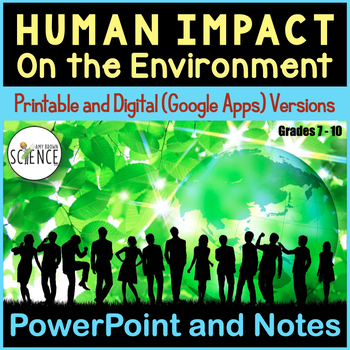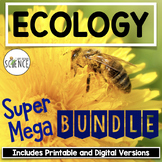Human Impact on the Environment PowerPoint and Notes
- Zip
- Google Apps™

What educators are saying
Also included in
- This NO PREP, PRINTABLE, EDITABLE, AND DIGITAL Biology Curriculum contains everything you need for an entire year of Biology! For less than $3 a day, you can save your time, energy, and sanity. Each of the 20 Complete Units includes a teaching PowerPoint presentation, notes, labs, homework assignmenPrice $525.00Original Price $988.18Save $463.18
- This "Humans and the Environment Complete Unit Bundle" includes everything you need to teach a unit on "Human Impact on the Environment" to your life science or biology students. From the engaging PowerPoint to the final unit test, this bundle contains loads of NO PREP materials that are ready to bePrice $29.50Original Price $37.97Save $8.47
- All of my ecology and environmental science resources (6 ecology unit bundles) are included in this one Super-Mega-Bundle! This mega-bundle includes all of the PowerPoints, notes, labs, task cards, homework assignments, review games, quizzes, activities, and unit tests that you need to teach a compPrice $178.00Original Price $252.64Save $74.64
Description
What is the ecological impact that humans have upon our fragile environment? This PowerPoint lesson is designed to teach students about the human behaviors that have consequences for our planet, such as the burning of fossil fuels, ozone depletion, overfishing, the clear cutting of forest areas and more. Choose to use the traditional printable version, or the paperless, digital Google Apps version. Our students are the decision makers of tomorrow. It is imperative that we give them the ecological knowledge (global warming, greenhouse effect, habitat destruction) they need so that they can make informed decisions about our future.
What is included in this resource?
- A 72-Slide PowerPoint Presentation (Includes traditional PowerPoint, PDF, and Google slides)
- Editable and Printable 8-page set of lecture notes for the teacher
- Editable and Printable 12-page guided notes outline for the student
- Paperless Digital Version for use in Google Drive, Google Classroom, and /or Microsoft OneDrive
This resource is perfect for distance learning and for students in 1:1 classrooms.
This colorful and engaging PowerPoint presentation, "The Human Impact on the Environment", will provide your students with interactive lessons on the impact humans have had (and are having!) on the biosphere. It consists of 72 slides that are colorful, informative and visually stimulating. Pictures and diagrams are included that will greatly enhance your instruction to your students. This product also includes a set of notes for the teacher (8 pages) and a "guided notes outline" for the student (12 pages). Graphics, diagrams, clip art, and photographs were chosen to capture the attention of the student as the lesson is being taught.
Topics covered in this lesson are:?
- Planet Earth and environmental science.
- A brief history of the human impact on planet Earth: Hunters and gatherers, agriculture, industry, and urban development.
- Renewable and Nonrenewable Resources: Definitions and examples.
- Sustainable development.
- Land resources: The importance of land, land as a renewable resource, composition of soil, human impact on soil, erosion, desertification, good land management.
- Forest resources: The importance of forests as a producer of human goods and services, the ecological role of the forests, renewable forests, nonrenewable forests, old growth forests, deforestation, good management of forests.
- Fishery resources: The importance of fisheries to humans and to the environment, overfishing, fisheries as a renewable resource, aquaculture.
- Air resources: Air quality, smog, the pollutants in smog, the burning of fossil fuels, acid rain.
- Freshwater resources: Water use by humans, how pollutants enter the water supply, the role of nature in the cleaning and purifying of water.
- The Human Influence on the Biosphere: Ozone depletion, rising levels of carbon dioxide, population growth.
- Ozone Depletion: Definition of ozone, importance of ozone in our atmosphere, the harmful effects of ultraviolet radiation, how humans are causing the destruction of the ozone, chlorofluorocarbons (CFC's), global regulations of CFC's.
- Increasing Levels of Carbon Dioxide: The role of carbon in the carbon cycle, the addition of too much carbon dioxide to the atmosphere, the danger of rising carbon dioxide levels, global warming, the greenhouse effect.
- Human Population Growth: Estimation of future population size and the effect this will have on our planet.
- Biodiversity: Definition of biodiversity, how biodiversity is measured, the importance of biodiversity, ways biodiversity is lost, extinction, the threat of pollution to biodiversity, keystone species, the use of DDT in the environment, biological magnification, the threat of invasive species.
This PowerPoint was written with a typical biology I class in mind. It can easily be edited to meet your needs.
This product includes a complete set of notes for the teacher, and an outline of the notes for the students. Students will use the outline as the PowerPoint is being presented and will fill in the notes as the lesson is being taught. I always include both the Word document and a pdf of the notes.
Related products include:
Lab: The Effect of Acid Rain on Seed Germination
Calculating Water Use and Energy Consumption in the Home
Humans and the Environment Task Cards
Human Impact on the Environment Set of 2 Homework Assignments
Human Impact on the Environment Review PowerPoint Questions and Answers
Quiz: Human Impact on the Environment
Human Impact on the Environment Unit Test
Introduction to Ecology PowerPoint with Notes for Teacher and Student
Population Ecology PowerPoint with Notes for Teacher and Student
Community Ecology PowerPoint with Notes for Teacher and Student
Ecosystems: Energy Flow and the Recycling of Matter PowerPoint with Notes for Teacher and Student
Ecosystems and the Biosphere: Biomes of the World PowerPoint with Notes for Teacher and Student
FREE Set of Six Ecology Crossword Puzzles
FREE! Backyard Ecology: An Ecological Assessment of Your Back Yard
For updates about sales and new products, please follow my store:








